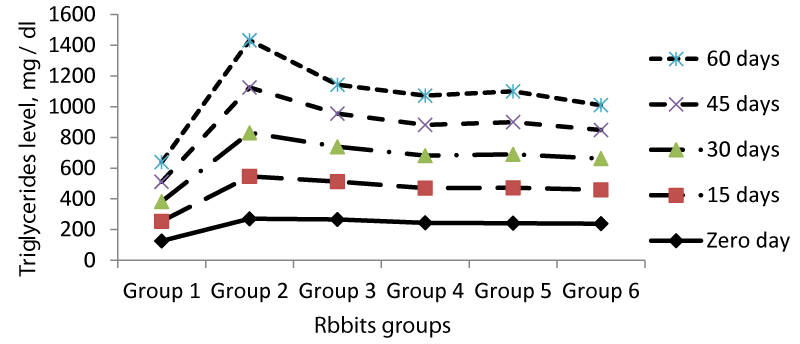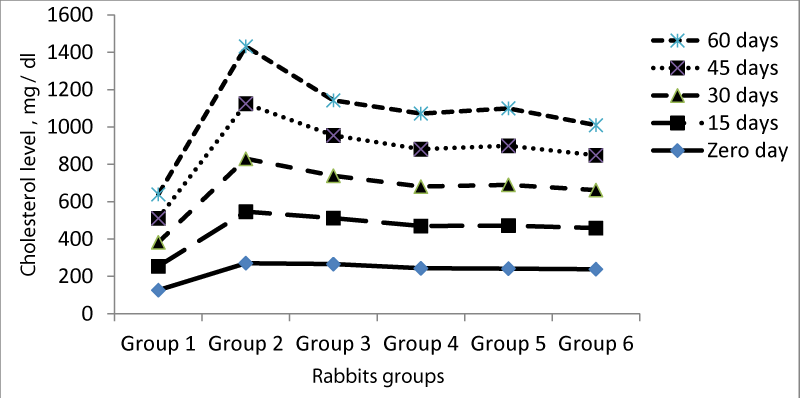International Journal of Veterinary Science and Research
Effect of camel milk and its derivatives on triglycerides and cholesterol level in alloxan-induced diabetic rabbits
Sahar A Elhassan1, Awad M Babeker2, Mohammed Alhadi Ebahiem1* and Sallam A Bakhiet1
2Department of Food Science and Technology, Faculty of Natural Resources and Environmental Studies, University of Kordofan, Sudan
Cite this as
Elhassan SA, Babeker AM, Ebahiem MA, Bakhiet SA (2022) Effect of camel milk and its derivatives on triglycerides and cholesterol level in alloxan-induced diabetic rabbits. Int J Vet Sci Res 8(1): 011-014. DOI: 10.17352/ijvsr.000105Copyright License
© 2022 Elhassan SA, et al. This is an open-access article distributed under the terms of the Creative Commons Attribution License, which permits unrestricted use, distribution, and reproduction in any medium, provided the original author and source are credited.This trial aimed to find out the effect of camel milk and its derivatives on triglycerides and cholesterol levels in Alloxan-Induced diabetic rabbits. Diabetes was induced by intravenous injection of Alloxan solution. The diabetic rabbits were treated with fresh and fermented camel milk and colostrums for 60 days. The results demonstrated that triglycerides and cholesterol levels were reduced throughout the experimental period when using camel milk and its derivatives and the levels were kept within the accepted ranges.
Introduction
The diet rich in saturated fats, smoking, lifestyle, and increased visceral fat is raising LDL (low-density lipoprotein) cholesterol levels [1]. Significant higher levels of triglycerides in Sudanese diabetic patients may be due to overproduction of VLDL (very- low-density lipoprotein) lead to increase plasma levels of triglyceride which, via an exchange process mediated by Cholesterol Ester Transfer Protein (CETP), result in lower levels of high-density lipoprotein HDL-cholesterol, which results in faulty glucose utilization causes hyperglycemia and mobilization of fatty acids from adipose tissue. In diabetes blood, glucose is not utilized by tissue resulting in hyperglycemia. The fatty acids from adipose tissue are mobilized for energy purposes and excess fatty acid is accumulated in the liver, which is converted to triglyceride [2].
Elevated levels of cholesterol in the blood are regarded as a major risk factor for heart disease. It has been demonstrated that the administration of fermented camel milk has a hypocholesterolemic effect in rats [3]. The hypo cholesterol mechanism of camel milk is still unclear, but different hypotheses were discussed, including the interaction between bioactive peptides from camel milk and cholesterol levels are derived, which lead to cholesterol-lowering [4] and the presence of orotic acid in camel milk (arises as an intermediate in the metabolism of the nucleic acids), which is considered responsible for the lowering of cholesterol levels in rats and in humans [5,6]. The data concerning the management of high Triglyceride (TG) levels and low HDL cholesterol levels remains inconclusive [7]. So this trial aimed to find out the effect of camel milk and its derivatives on Triglycerides and Cholesterol levels in Alloxan-Induced diabetic rabbits.
Materials and methods
Materials
The material used includes a thermostatic water bath at 37°C and analyzer, blood samples.
Methods
Experimental design: Thirty clinically normal one-year-old rabbits of both sexes on an average weight of 3-3.5Kg were provided; Completely Randomized Design (CRD) was used where they were divided into six groups each with five rabbits. The animals were fed with green carrot (Caucus Carrot) and tap water and provided with air-conditioned quarters at 24°C under standard husbandry conditions in the University of Kordofan exponential farm for 60 days during January 2021.
Alloxan inducing diabetes: Diabetes in the rabbits was induced by intravenous injection of Alloxan [7]. A fresh solution of Alloxan was prepared and the rabbits in five groups were administered 80mg/Kg body weight of the solution while one group was left untreated with Alloxan as a control group. After a week of Alloxan injection, diabetes was confirmed through the measurement of blood glucose levels from heart blood using a glucometer (Prestige). Rabbits with blood glucose concentrations ≥ 8.0mm. ol/L were selected for the experiment.
Treatment groups: The treated groups were designated as follow:
- Group 1 (control) to which no Alloxan induction no Fresh camel milk, colostrums, and fermented camel milk supplementation.
- Group 2 (diabetic-non supplemented) to which diabetes was induced but no Fresh camel milk, colostrums, and fermented camel milk supplementation.
- Group 3 (diabetic-treated) to which diabetes was induced and supplemented with fresh camel milk, each rabbit in Group 3 was daily treated with 5ml of camel milk using a 5ml syringe for oral administration for 4 weeks, and the dose was then increased to 5ml for additional 8 weeks.
- Group 4 (diabetic-treated) to which diabetes was induced and supplemented with5ml of Colostrums, each rabbit in Group 4 was treated daily with Colostrums using a 5ml syringe for oral administration for 4 weeks where the dose was then increased to 5ml for additional 8 weeks.
- Group 5 (diabetic-treated) to which diabetes was induced and supplements with5ml of fermented camel milk, each rabbit in Group 5 were daily treated with Gars using a 5ml syringe for oral administration for 4 weeks and the dose was then increased to 5ml for additional 8 weeks.
- Group 6 (diabetic-treated) to which diabetes was induced and supplemented with Insulin and each rabbit in Group 6 was daily treated with Insulin by injection (16mg/kg body wt) for 12 weeks.
Determination of Cholesterol
Cholesterol in the blood of rabbits was measured every 15 days for a total period of 60 days.
Serum Total Cholesterol (TC) was determined according to [8] as follow:
- Serum or plasma is collected by standard procedures. Cholesterol was stable for 7 days at 2–8°C. Heparin, EDTA, oxalate, and fluoride were used as anticoagulants.
- The reagent was brought to room temperature; a pipette was placed into a labeled test tube. The serum was mixed thoroughly and the tube was incubated for 10 minutes at room temperature (16-25°C) or 5 minutes at 37°C. The absorbance (A) of the cholesterol standard and sample at 500nm against the blank was measured. The color was stabled for at least 2 hours. The cholesterol was determined using the following equation:
Determination of triglyceride
Serum triglycerides (TAG) were determined according to [9]. Serum or plasma was collected by standard procedures where Triglycerides in serum or plasma were stable for 5 days at 2-8°C. Heparin, EDTA, oxalate, and fluoride were used as anticoagulants. Test steps were as follow:
- The reagent was brought to room temperature.
- The pipette was placed into labeled test tubes.
- Mix thoroughly and incubate the tubes for 15 minutes at room temperature (16-25°C) or 5 minutes at 37°C.
- Measurement of the absorbance (A) of the standard and sample at 500nm against the blank. The color was stable for at least 2 hours.
The Triglycerides concentration in the sample was calculated using the following general formula:
Results and discussion
Effect of camel milk and derivatives on Triglycerides level in diabetic rabbits
Table 1 and Figure 1; demonstrated that Group 1 (nondiabetic - none supplemented) showed Triglycerides (TAG) levels which fluctuated between 142.6 to 145.4mg/dl throughout the period of the experiment from 0-60 days. In the case of Group 2 (diabetic-non supplemented) level of Triglycerides was increased from 239.4mg/dl at 0 days to reach the level of 338mg/dl at 60 days as the highest value as compared with other groups. From 0-60 days, in Group 3 (diabetic-treated with colostrums) Triglycerides decreased from 229.5mg/dl to 165.0mg/dl, in Group 4 (diabetic-treated with milk) decreased from 227.3mg/dl to 173.0mg/dl, in Group 5 (diabetic-treated with gars) from 208.1mg/dl to 179.8 mg/dl and in Group 6 (diabetic-treated with Insulin16 mg for each kg body weight daily for 8 weeks) decreased from 224.4mg/dl to 164.7mg/dl. It was demonstrated that there were no significant differences in Triglycerides levels between Group 1 (control), Group 3, Group 4, Group 5, and Group 6 at 0.05 level of significance, and the values were found to be within the normal level range (140-176mg/dl), the highest level of Triglycerides level at 60 days was recorded by Group 2 (diabetic-non supplemented). It is concluded that treatments of diabetic rabbits with colostrums, camel milk, gars, and insulin resulted in decreasing Triglycerides levels and kept within the normal level.
Effect of camel milk and derivatives on Cholesterol level in diabetic rabbits
In Table 2 and Figure 2; Group 1 (nondiabetic - none supplemented) demonstrated Cholesterol (TC) levels which fluctuated between 126.0 to 129.0 mg/dl throughout the experimental period from 0-60 days and were found to be within the normal range (100-200mg/dl). In the case of Group 2 (diabetic-non supplemented) level of total Cholesterol was increased from 270.4 mg/dl at 0 days to reach the maximum level of 306.7 mg/dl at 60 days as the highest value as compared with other groups and it was above the normal limits. From 0 day to 60 days, in Group 3 (diabetic-treated with colostrums) total Cholesterol level decreased from 265.8mg/dl to 187.9mg/dl, in Group 4 (diabetic-treated with milk) decreased from 243.8mg/dl to 190.5mg/dl, in Group 5 (diabetic-treated with gars) from 241.4mg/dl to 200.0 mg/dl and in Group 6 (diabetic-treated with Insulin16 mg/kg body weight daily for 8 weeks) decreased from 238.5mg/dl to 161.4mg/dl. It was demonstrated that there were no significant differences in total Cholesterol levels between Group 3, Group 4, Group 5, and Group 6 at 0.05 level of significance, and the values were found to be within the normal range (100-200mg/dl), the highest level of total Cholesterol level at 60 days was recorded by Group 2 (diabetic-non supplemented). It is deduced that treatments of diabetic rabbits with colostrums, camel milk, gars, and insulin resulted in decreasing total Cholesterol levels, kept within the normal levels, and maintained at desirable levels (less than 200). The obtained results were found to be in the line with [5,6] findings.
Conclusion
Diabetic rabbits treated with fresh and fermented camel milk and colostrums reduced the Triglycerides levels to be retained within the required level. Treatments of diabetic rabbits with fresh and fermented camel milk and colostrums decreased the total cholesterol levels to be kept within the normal range and maintained at a desirable level.
- Elnasri HA, Ahmed AM (2018) Patterns of lipid changes among type 2 diabetes patients in Sudan. East Mediterr Health J 14: 314-324. Link: https://bit.ly/3fAg4WD
- Amos AF, McCarty DJ, Zimmet P (2010) The rising global burden of diabetes and its complications. Diabet Med 14: S7-S85. Link: https://bit.ly/33NPqXk
- Elayan AA, Sulieman AE, Saleh FA (2008) The hypocholesterolemic effect of Gariss and Gariss containing Bifid bacteria in rats fed on a cholesterol-enriched diet. Asian J Biochem 3: 43-47. Link: https://bit.ly/32d4DAV
- Li H, Papadopoulos V (2008) Peripheral-type benzodiazepine receptor function in cholesterol transport. Identification of a putative cholesterol recognition/interaction amino acid sequence and consensus pattern. Endocrinology 139: 4991-4997. Link: https://bit.ly/355p4kv
- Rao DR, Chawan CB, Pulusani SR (2006) Influence of milk and thermophilus milk on plasma cholesterol levels and hepatic cholesterogenesis in rates. J Food Sci 46: 1339-1341. Link: https://bit.ly/3GGBuxa
- Buonopane GJ, Kilara A, Smith JS, McCarthy RD (2002) Effect of skim milk supplementation on blood cholesterol concentration, blood pressure, and triglycerides in a free-living human population. J Am Coll Nutr 11: 56-67. Link: https://bit.ly/3fJkvOB
- Pyŏrälä K, Pedersen TR, Kjekshus J, Faergeman O, Olsson AG, et al. (2010) Cholesterol lowering with simvastatin improves prognosis of diabetic patients with coronary heart disease: a subgroup analysis of the Scandinavian Simvastatin Survival Study (4S). Diabetes Care 20: 614-620. Link: https://bit.ly/34Xru4t
- Allain CC, Poon LS, Chan CS, Richmond W, Fu PC (1974) Enzymatic determination of total serum cholesterol. Clin Chem 20: 470-475. Link: https://bit.ly/3KhhFyu
- Tietz, NW, Finley PR, Pruden EL (1990) Clinical Guide to Laboratory Tests. 2nd Edition, W.B. Saunders, Philadelphia 304-306. Link: Link: https://bit.ly/3AeEzlK
Article Alerts
Subscribe to our articles alerts and stay tuned.
 This work is licensed under a Creative Commons Attribution 4.0 International License.
This work is licensed under a Creative Commons Attribution 4.0 International License.



 Save to Mendeley
Save to Mendeley
